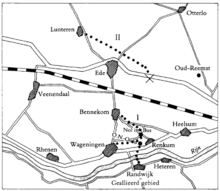Operation Pegasus
| Operation Pegasus | |
|---|---|
| Part of the Battle of Arnhem | |

Map of Pegasus I and II
|
|
| Type | Evacuation |
| Location | Lower Rhine at Renkum, the Netherlands |
| Planned by | Lt Colonel David Dobie Major Digby Tatham-Warter , Dutch resistance |
| Objective | Safely evacuate survivors of the British 1st Airborne Division |
| Date | Night of 22/23 October 1944 2100 – 0200 |
| Executed by |
Royal Canadian Engineers 506 PIR, 101st Airborne Division Dutch resistance |
| Outcome | 138 men evacuated |
| Casualties | 1 man (missing) |
| Operation Pegasus II | |
|---|---|
| Part of the Battle of Arnhem | |
| Type | Evacuation |
| Location | Lower Rhine at Oosterbeek, the Netherlands |
| Objective | Safely withdraw escapees north of the Lower Rhine |
| Date | Night of 18 November 1944 |
| Outcome | Failure |
Operation Pegasus was a military operation carried out on the Lower Rhine near the village of Renkum, close to Arnhem in the Netherlands. Overnight on 22–23 October 1944, the Allies successfully evacuated a large group of men trapped in German occupied territory who had been in hiding since the Battle of Arnhem.
The fighting north of the Rhine in September had forced the 1st British Airborne division to withdraw, leaving several thousand men behind. Several hundred of these were able to evade capture and go into hiding, usually with the assistance of the Dutch Resistance. Initially the men hoped to be able to wait for the British 2nd Army to resume their advance and thus relieve them, but when it became clear that the Allies would not cross the Rhine that year the men decided to escape back to Allied territory. The first escape operation was a great success and over 100 men were able to return to their own lines, but a second operation was compromised and failed. Despite this the resistance continued to help the evaders and many more men were able to escape in small groups over the winter.
In September 1944 the Western Allies launched Operation Market Garden, an attempt by the British 2nd Army to bypass the Siegfried Line and advance into the Ruhr, Germany’s industrial heartland. The operation required the First Allied Airborne Army to seize several bridges over rivers and canals in the Netherlands, allowing ground forces to advance and cross the Lower Rhine at Arnhem.
The 1st British Airborne Division dropped onto Arnhem on 17 September. They encountered far greater resistance than had been expected and only a small force were able to reach Arnhem road bridge. XXX Corps ground advance became delayed and without reinforcement this small force under Lt Colonel John Frost was overwhelmed. The rest of the division became trapped in a small perimeter in Oosterbeek and were withdrawn on the night of 25–26 September in Operation Berlin.
...
Wikipedia
